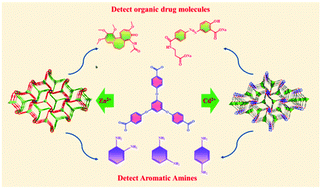Three-pole wheel paddle luminescent metal organic frameworks (LMOFs) based on the oxygen substituted triazine tricarboxylic acid ligand: recognition and detection of small drug molecules and aromatic amine molecules†
Abstract
Luminescent metal organic frameworks (LMOFs) are considered to be a type of promising optical sensing material due to their designable and tunable functions, and stable pore structures. Therefore, the preparation of LMOFs has become a research hotspot in recent years. As we know, triazine carboxylic acid ligands are conducive for constructing LMOF materials due to their large π electron conjugated system. In this work, two crystalline materials [Cd3(TCPT)2]·0.5DMF·4H2O (1) and (H3O)[Zn2(TCPT)(μ2-OH)2]·0.5DMF·3H2O (2) were obtained by the reaction of the triazine carboxylic acid ligand 2,4,6-tris(4-carboxyphenoxy)-1,3,5-triazine (H3TCPT), as an extended carboxylate arm, and d10 transition metal salts. Their structures were determined by single crystal X-ray diffraction and characterized by infrared spectroscopy (IR), ultraviolet visible spectroscopy (UV-vis), fluorescence spectroscopy, powder X-ray diffraction (PXRD) and thermogravimetric analysis (TG). The experimental results showed that complexes 1 and 2 show excellent fluorescent emission behavior. Thus, we explored their fluorescence sensing properties. To our delight, the results showed that they both had the ability to sense small organic drug molecules and aromatic amine molecules containing o-phenylenediamine (OPD), m-phenylenediamine (MPD) and p-phenylenediamine (PPD). In general, the practical applications of a MOF material are usually limited because of the relatively harsh synthesis methods. In this aspect, we studied the synthesis method in detail to obtain the optimal reaction conditions for the large-scale synthesis of 1 and 2. The preparation of the two LMOF materials only required about 3 hours of heating time and they could be prepared on a large scale, which is significant for the practical applications of LMOFs.



 Please wait while we load your content...
Please wait while we load your content...